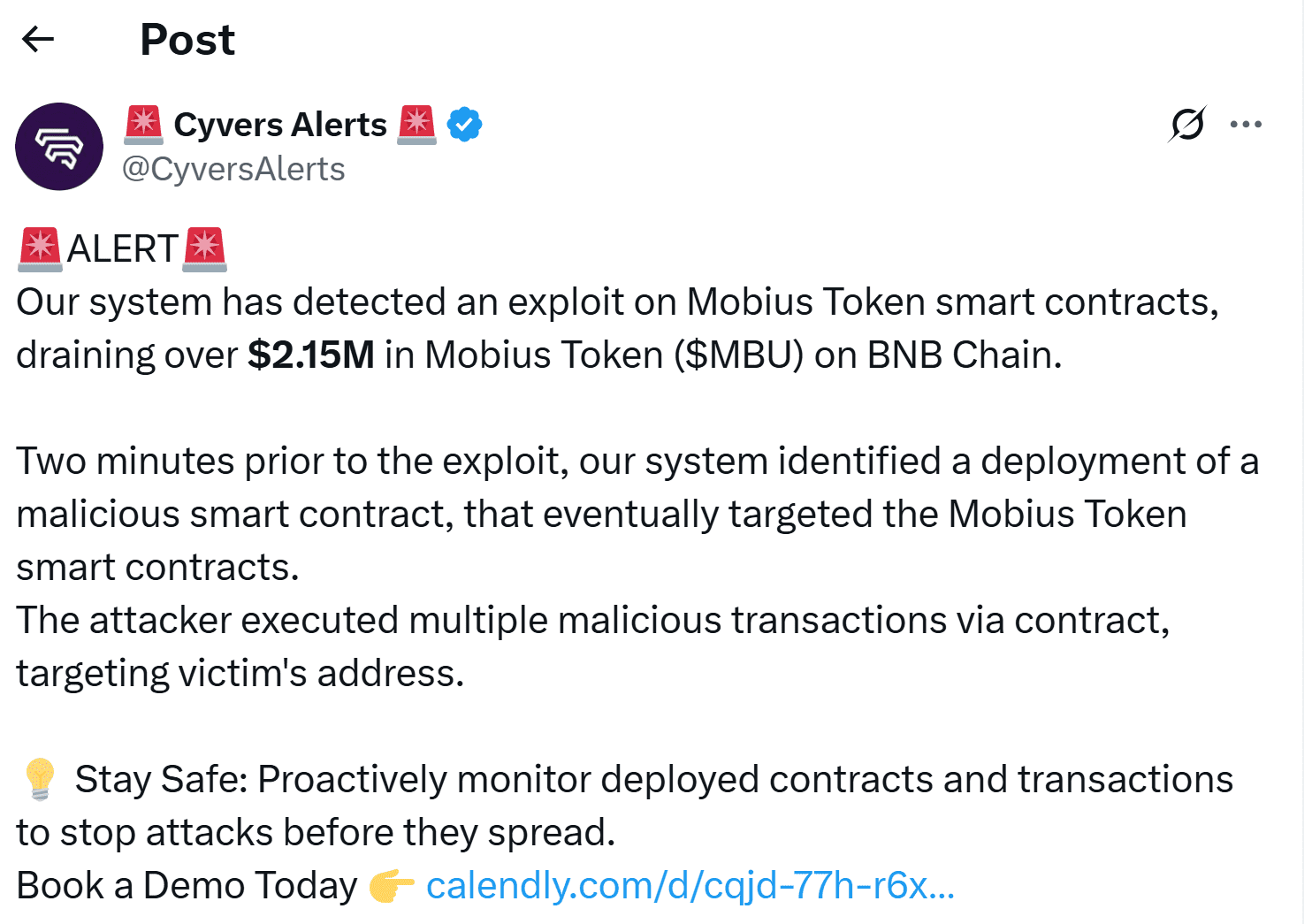Mobius Token Exploit: $2.1M Drained from BNB Chain Smart Contracts – A Deep Dive
On May 11, 2025, Mobius Token ($MBU) smart contracts on the BNB Chain were targeted in a sophisticated exploit, resulting in the theft of over $2.1 million. Security firm Cyvers Alerts detected the attack in its early stages, providing crucial details about the attacker’s methods and the impacted funds.
Exploit Details and Timeline
The attacker deployed a malicious contract from address 0xb32a53... at 07:31:38 UTC. Just two minutes later, at 07:33:56 UTC, the exploit was initiated, draining funds from the victim wallet 0xb5252f.... Cyvers Alerts identified contract 0x631adf... as the key instrument used to execute a series of malicious transactions.
The smart contract successfully drained 28.5 million MBU tokens. These tokens were then converted into stablecoins, resulting in a net loss of $2,152,219.99 for the victim.
In summary, the attacker’s actions involved:
- Deployment of a malicious smart contract.
- Draining 28.5 million MBU tokens from the victim’s wallet.
- Converting the stolen tokens into $2.15 million worth of USDT (Tether).
Cyvers Alerts characterized the exploit as “critical,” emphasizing the suspicious nature of the contract code and the abnormal transaction patterns observed.
As of publication, the attacker’s wallet remains active, holding the stolen funds. The Mobius Token team has not yet released an official statement regarding the incident.
Cyvers Alerts stated on X (formerly Twitter): “Two minutes prior to the exploit, our system identified a deployment of a malicious smart contract that eventually targeted the Mobius Token smart contracts.” This highlights the importance of real-time threat detection and proactive security measures in the cryptocurrency space.

Broader Context: Crypto Losses in April 2025
The Mobius Token exploit is just one example of the increasing frequency and severity of cryptocurrency-related hacks and exploits. Blockchain security firm PeckShield reported that in April 2025 alone, nearly $360 million in digital assets were stolen across 18 hacking incidents.
This represents a staggering 990% increase compared to March, when crypto losses to hacks totaled approximately $33 million. A significant portion of April’s losses stemmed from an unauthorized Bitcoin transfer, later identified as a social engineering attack targeting an elderly individual in the United States.
On April 28, blockchain investigator ZachXBT flagged a suspicious transfer of $330 million in BTC. Further investigation revealed that the transfer was the result of a sophisticated social engineering attack targeting a vulnerable individual.
Understanding the Attack Vectors
Several factors contribute to the vulnerability of cryptocurrency projects to exploits like the Mobius Token incident. These include:
- Smart Contract Vulnerabilities: Flaws in the code of smart contracts can be exploited by attackers to drain funds or manipulate the contract’s behavior.
- Social Engineering: Attackers may use deception and manipulation to trick individuals into revealing private keys or transferring funds.
- Lack of Security Audits: Insufficient security audits can leave vulnerabilities undetected, increasing the risk of exploitation.
- Centralized Control: Projects with centralized control points are more susceptible to attacks targeting those points of control.
Mitigation Strategies and Best Practices
To protect against future attacks, cryptocurrency projects should implement the following mitigation strategies:
- Comprehensive Security Audits: Conduct regular security audits by reputable firms to identify and address potential vulnerabilities in smart contracts and other critical systems.
- Multi-Signature Wallets: Implement multi-signature wallets to require multiple approvals for transactions, reducing the risk of unauthorized access.
- Real-Time Monitoring and Alerting: Use real-time monitoring and alerting systems to detect suspicious activity and respond quickly to potential threats. Cyvers Alerts is an example of such a system.
- User Education: Educate users about the risks of social engineering and phishing attacks, and provide guidance on how to protect their private keys and funds.
- Decentralization: Promote decentralization to reduce reliance on centralized control points and increase the resilience of the project to attacks.
Conclusion
The Mobius Token exploit serves as a stark reminder of the ongoing security challenges in the cryptocurrency space. By understanding the attack vectors, implementing robust mitigation strategies, and fostering a culture of security awareness, cryptocurrency projects can better protect themselves and their users from future exploits. The quick detection by Cyvers Alerts demonstrates the value of proactive security monitoring. As the cryptocurrency landscape continues to evolve, staying ahead of emerging threats and adopting best practices will be crucial for ensuring the long-term security and stability of the industry.